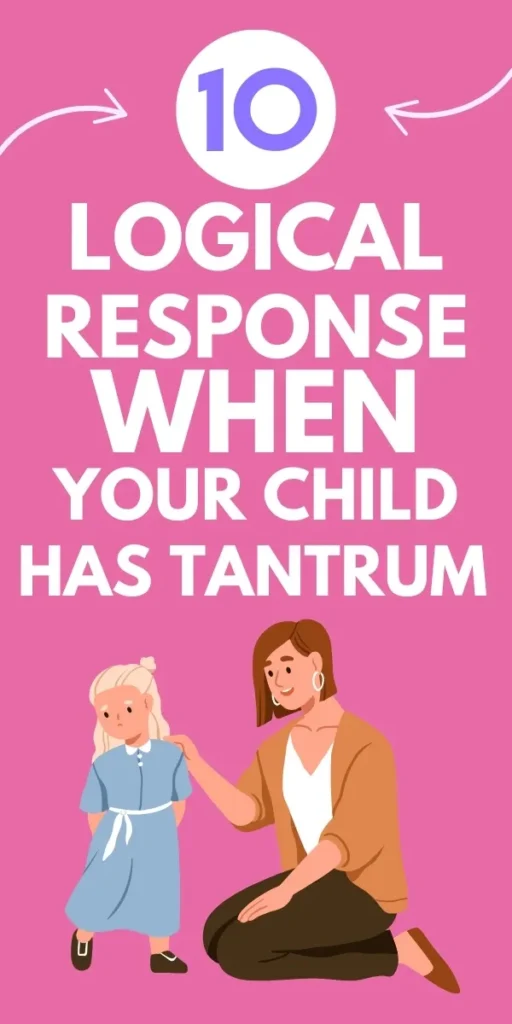Ever find yourself in the middle of a grocery store showdown with your little one. Feeling like you’re starring in a chaotic sitcom? Trust me, we’ve all been there.
Well, fear not! I’ve got your back with Best way to deal with tantrums and 10 logical responses for those tough moments when your little one decides to put on a show.
Why Do Kids Throw Temper Tantrums?
- Kids throw tantrums because they’re still learning to express their emotions and cope with frustrations.
- Tantrums can stem from hunger, tiredness, overstimulation, or simply not getting what they want.
Also Read: How we trigger our child’s anger?
Best Way to Deal with Tantrums
When your child is in meltdown mode, remember to stay calm yourself. Take a deep breath and respond with empathy and understanding. Here’s how:
- Stay Calm: Your child looks to you for cues on how to handle emotions, so model the behavior you want to see.
- Acknowledge Feelings: Validate your child’s emotions by saying, “I see you’re upset. It’s okay to feel that way.”
- Set Limits: Firmly but gently enforce boundaries. Let them know what behavior is unacceptable.
- Offer Choices: Provide options to empower your child and give them a sense of control.
- Redirect Attention: Distract your child with a different activity or object to shift focus away from the trigger.
Are Tantrums Normal?
Yes, tantrums are a normal part of child development, especially in toddlers and preschoolers.
However, if tantrums persist beyond a certain age or interfere with daily functioning, it may be worth seeking professional advice.
Common Tantrum Triggers in Toddlers, Preschoolers, and Grade School

Toddlers
- Hunger: Low blood sugar levels can lead to irritability and tantrums.
- Fatigue: Toddlers may become cranky when they’re tired and in need of rest.
- Overstimulation: Too much noise, activity, or sensory input can overwhelm toddlers.
Preschoolers
- Frustration: Difficulty in completing tasks or achieving goals can trigger tantrums.
- Transitioning Between Activities: Preschoolers may resist transitions from one activity to another.
- Wanting Independence: Preschoolers crave autonomy and may assert their independence through tantrums.
Grade School
- Peer Pressure: Social dynamics and peer interactions can cause stress and emotional outbursts.
- Academic Stress: Pressure to perform well in school or fear of failure can lead to anxiety and tantrums.
- Changes in Routine: Disruptions to established routines, such as changes in schedule or environment, can be challenging for grade school children.
Understanding these triggers can help parents anticipate and manage tantrums more effectively at different stages of childhood.
10 Logical Responses for Tantrums

1. Show Them How to Find Their Calm with Deep Breaths
Teaching your child simple calming techniques, like deep breathing, can empower them to regulate their emotions.
Example: “Let’s take a big breath together, like this. Inhale… and exhale. Feel better? We can do this whenever we need to calm down.”
2. Teach Problem-Solving
Encourage your child to brainstorm solutions to their problems. Problem-solving skills empower children to take control of their situations and find constructive ways to address challenges.
Example: “What can we do to make this situation better? Let’s think of some ideas together. Maybe we can find a different game to play or ask for help from a friend.”
3. Validate Emotions
Let your child know it’s okay to feel angry or frustrated. By acknowledging their emotions, you’re helping them understand and accept their feelings.
Example: “I understand you’re upset because we can’t buy that toy today. It’s disappointing when we can’t get what we want, isn’t it? Let’s figure out another fun activity we can do together instead.”
4. Tell them what they can’t do at the Moment in a Positive Way
Providing a clear explanation for why certain actions aren’t possible can help your child understand and accept limits.
Example: “I know you really want to play outside, but it’s raining right now. We can have just as much fun indoors with our puzzles!”
5. Provide Comfort
Offer hugs or soothing words to reassure your child. Physical touch and verbal affirmations convey love and support during moments of distress.
Example: “I’m here for you, sweetheart. Let’s snuggle up together and talk about what’s bothering you. Remember, I love you no matter what.”
6. Create a Distraction but Don’t Neglect Feelings
Sometimes, a well-timed distraction can help defuse a tantrum. However, it’s essential to acknowledge your child’s feelings first. Here’s how:
Example: “I understand you’re upset because we can’t buy that toy today. How about we go look at the books instead? You love stories, don’t you?”
7. Don’t Give in to Their Tantrums
It’s tempting to give in to your child’s demands to stop the tantrum, but doing so can reinforce the behavior.
Example: “I understand you’re upset, but throwing toys is not safe. We can talk about it once you’ve calmed down.”
8. Give Them Simple Choices
Offering your child choices can give them a sense of control and help prevent meltdowns. Keep the options simple and manageable.
Example: “Would you like to wear the red shirt or the blue shirt today? You get to decide!”
9. Practice Empathy
Put yourself in your child’s shoes and empathize with their feelings. Understanding their perspective helps validate their emotions and strengthens your bond.
Example: “I understand how disappointing it is when things don’t go your way. It’s frustrating when our plans change unexpectedly. Let’s work together to find a solution that makes us both happy.”
10. Use Positive Reinforcement
Praise good behavior to encourage more of it. Positive reinforcement helps reinforce desirable actions and builds your child’s confidence.
Example: “Thank you for calming down and using your words to tell me what you need. I appreciate how you’re trying to communicate with me. That’s very mature of you!”
What NOT to Do During Tantrums
- Don’t Give in to Demands: Avoid reinforcing tantrums by giving in to your child’s demands.
- Avoid Punishment: Punishment can escalate the situation and lead to more meltdowns.
- Don’t Yell or Shame: Stay calm and refrain from yelling or shaming your child, as it can worsen their distress.
- Avoid Ignoring: Ignoring your child’s tantrums may make them feel unheard and escalate the behavior.
- Don’t Compare: Comparing your child to others or their siblings can undermine their self-esteem and worsen tantrums.
Conclusion
Dealing with tantrums and meltdowns is no easy feat, but now you’re equipped with these logical responses and insights into common triggers.
So now you can handle whatever curveballs your little one throws your way.
Remember, tantrums are just a normal part of childhood development, and with patience, empathy, and a sprinkle of humor, you’ll emerge from the chaos with your sanity intact.

